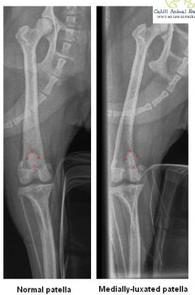DanBar Ranch
The patella (knee cap) is held in place by a combination of ligaments and the grooved track in which it sits. When this track is too shallow and the knee cap pops out of and back into place, this is called patellar luxation. It is usually a genetic issue and it is most common in small breed dogs like the cairn terrier. Dogs that are going to be bred should always be examined by a veterinarian to rule out patellar luxation. Affected dogs should not be bred.
DanBar Ranch breeding philosophy is to spare no expense in producing SOUND dogs; canine athletes able to hike, swim, jog or do any dog sport such as agility you may want to play. Health testing is the ONLY way to assure myself that I am using sound dogs for breeding. It's just too important to produce healthy dogs to make excuses about why I don't want to OFA.
Health Testing: LUXATING PATELLA
Above: x-ray showing the knee cap displacement in "luxating patellas".
TESTING AVAILABLE FOR LUXATING PATELLA
Local veterinarians can perform this easy, inexpensive test which only involves the vet manipulation of the knee cap and feeling for looseness and instability. The Orthopedic Foundation for Animals (OFA) keeps the results and statistics.
After the local vet makes their examination, the results are recorded by the OFA. This is a "pass/fail" test, however if laxity is discovered, the knees will be graded for severity. Grade One is the least severe.
The OFA will give out a final "official" rating only after the dog is 24 months of age. However, it will read films of younger dogs and these are called "prelims". The OFA states on its website that the correlation between the rating of a prelim being the same as the final reading is better than 95%.
CAIRNS: according to OFA statistics (as of 2019) cairns are "mid pack" where patella issues are concerned. They are 36th worse out of 136 breeds tested. This makes it important that breeds test all their dogs so that the issue can be gotten under control before it gets worse.
DOBERMANS: according to OFA statistics, I am glad to report that the Doberman is reported with 100% passing rate for patella tests. This is good news indeed, but by testing reputable breeders can KEEP IT THAT WAY!
Understand the nature of luxating patellas...
If you have ever seen a dog, particularly a little dog, "skip" or hop on one back leg when trotting away from you, chances are that dog has luxating patellas (slipping knee caps). The range of severity is wide, from the occasional skip to dogs which become absolute cripples in middle age.
Dogs can be examined by the breeder's local veterinarian, and if there is any looseness of the knee cap (patella) the vet will assign it a "grade" (how severe the issue is). Luxating patellas are a pretty common problem in dogs, and the impact on each dog depends on a variety of issues such as the weight of the dog (is it obese) amount of exercise the dog gets and how that exercise is given. Example: if a dog is made to live for many hours a week in a crate where it cannot move about or exercise at all, and then is allowed to be a "weekend warrior", this sets the dog up for not only patella issues but torn cruciates.
The Patellar Luxation Database is for dogs 12 months and over. Examinations performed on dogs less than 12 months will be treated as consultations and no OFA numbers will be assigned.
A method of classifying the degree of luxation and bony deformity is useful for diagnosis and can be applied to either medial or lateral luxations by reversing the medial-lateral directional references. The position of the patella can easily be palpated starting at the tibial tubercle and working proximally along the patellar ligament to the patella.
Grade 1: Manually the patella easily luxates at full extension of the stifle joint, but returns to the trochlea when released. No crepitation is apparent. The medial, or very occasionally, lateral deviation of the tibial crest (with lateral luxation of the patella) is only minimal, and there is a very slight rotation of the tibia. Flexion and extension of the stifle are in a straight line with no abduction of the hock.
Grade 2: There is frequent patellar luxation, which, in some cases, becomes more or less permanent. The limb is sometimes carried, although weight bearing routinely occurs with the stifle remaining slightly flexed. Especially under anesthesia, it is often possible to reduce the luxation by manually turning the tibia laterally, but the patella reluxates with ease when manual tension of the joint is released. As much as 30 degrees of medial tibial torsion and a slight medial deviation of the tibial crest may exist. When the patella is resting medially the hock is slightly abducted. If the condition is bilateral, more weight is shifted onto the forelimbs. Many dogs with this grade live with the condition reasonably well for many years, but the constant luxation of the patella over the medial trochlear ridge of the trochlea causes erosion of the articulating surface of the patella and also the proximal area of the medial lip. This results in crepitation becoming apparent when the patella is luxated manually.
Grade 3: The patella is permanently luxated with torsion of the tibia and deviation of the tibial crest of between 30 degrees and 50 degrees from the cranial/caudal plane. Although the luxation is not intermittent, many animals use the limb with the stifle held in a semi-flexed position. The trochlea is very shallow or even flattened.
Grade 4: The tibia is medially twisted and the tibial crest may show further deviation medially with the result that it lies 50 degrees to 90 degrees from the cranial/caudal plane. The patella is permanently luxated. The patella lies just above the medial condyle and space can be palpated between the patellar ligament and the distal end of the femur. The trochlea is absent or even convex. The limb is carried, or the animal moves in a crouched position, with the limb flexed.
May the coonhound.





